Coburn J.W. Algebra and Trigonometry
Подождите немного. Документ загружается.

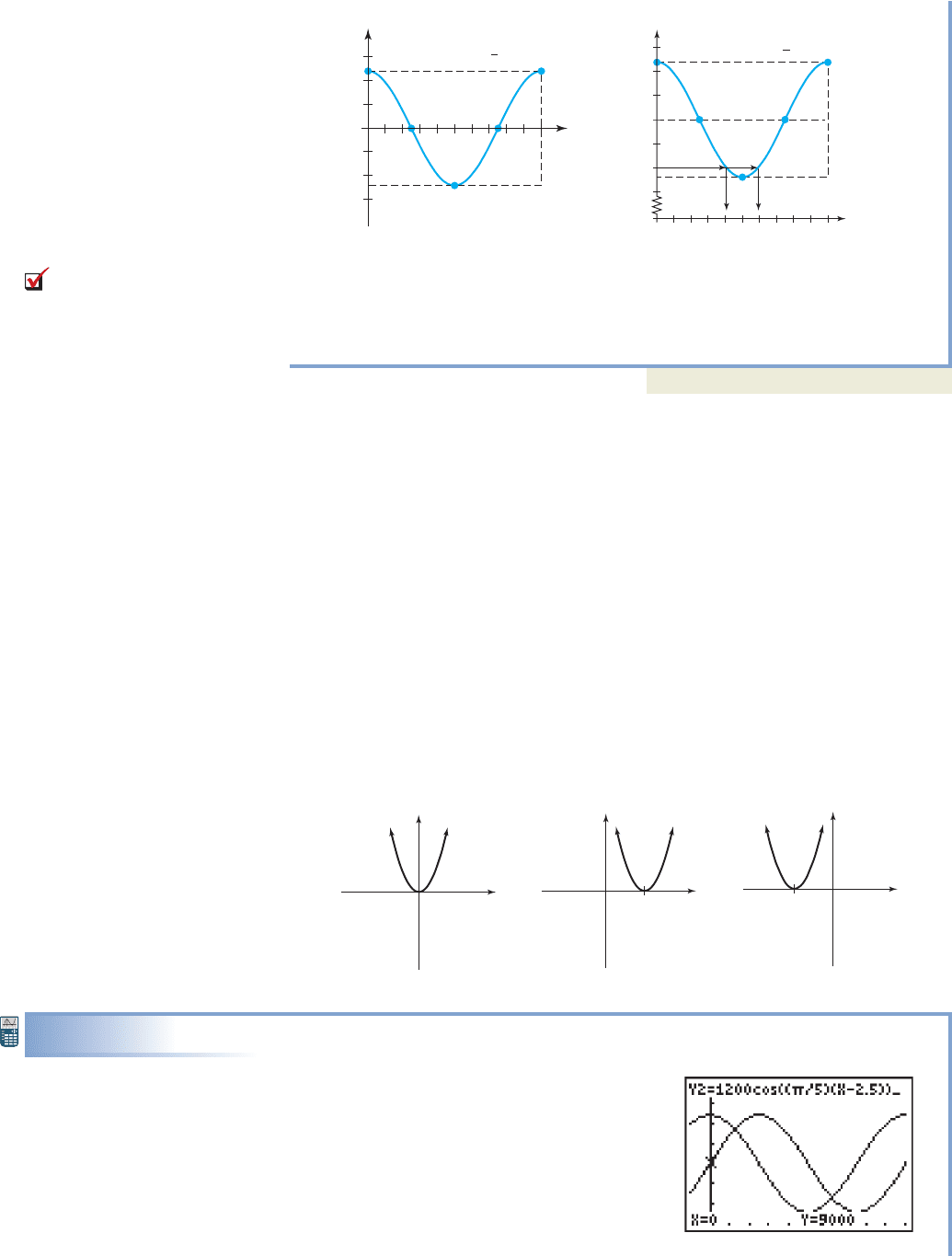
590 CHAPTER 5 An Introduction to Trigonometric Functions 5-88
c. The maximum value is and the minimum value is
d. As determined from the graph, the population drops below 8000 animals for
approximately 2 yr. Verify by computing P(4) and P(6).
Now try Exercises 19 and 20
B. Horizontal Translations:
In some cases, scientists would rather “benchmark” their study of sinusoidal phe-
nomena by placing the average value at instead of a maximum value (as in
Example 2), or by placing the maximum or minimum value at instead of the
average value (as in Example 1). Rather than make additional studies or recompute
using available data, we can simply shift these graphs using a horizontal translation.
To help understand how, consider the graph of . The graph is a parabola, concave
up, with a vertex at the origin. Comparing this function with and
we note y
1
is simply the parent graph shifted 3 units right, and y
2
is the
parent graph shifted 3 units left (“opposite the sign”). See Figures 5.84 through 5.86.
While quadratic functions have no maximum value if these graphs are
a good reminder of how a basic graph can be horizontally shifted. We simply replace
the independent variable x with or t with where h is the desired shift
and the sign is chosen depending on the direction of the shift.
EXAMPLE 3
Investigating Horizontal Shifts of a Trigonometric Graph
Use a horizontal translation to shift the graph
from Example 2 so that the average
population begins at Verify the result
on a graphing calculator, then find a sine
function that gives the same graph as the
shifted cosine function.
t 0.
x
y
3
x
y
3
x
y
1t h2, 1x h2
A 0,
y
2
1x 32
2
,
y
1
1x 32
2
y x
2
t 0
t 0
y A sin1Bt C2 D
9000 1200 7800.
9000 1200 10,200
246810
1500
1500
1000
500
0
1000
500
y 1200 cos t
5
P
t (years)
P(t) 1200 cos t 9000
5
10
2468
0
t (years)
Average value
P
10,500
10,000
9500
9000
8000
8500
7500
(d)
Figure 5.82 Figure 5.83
A. You’ve just learned how
to apply vertical translations
in context
Figure 5.84 Figure 5.85 Figure 5.86
y x
2
y
1
(x 3)
2
y
2
(x 3)
2
010
7000
11,000
College Algebra & Trignometry—
cob19529_ch05_503-614.qxd 12/27/08 10:58 Page 590

5-89 Section 5.7 Transformations and Applications of Trigonometric Graphs 591
Solution
For from Example 2, the average value first occurs
at For the average value to occur at we must shift the graph to the right
2.5 units. Replacing t with gives
A graphing calculator shows the desired result is obtained (see figure). The new
graph appears to be a sine function with the same amplitude and period, and the
equation is
Now try Exercises 21 and 22
Equations like from Example 3 are said
to be written in shifted form, since we can easily tell the magnitude and direc-
tion of the shift. To obtain the standard form we distribute the value of B:
In general, the standard form of a sinusoidal
equation (using either a cosine or sine function) is written
with the shifted form found by factoring out B from :
In either case, C gives what is known as the phase angle of the function, and is
used in a study of AC circuits and other areas, to discuss how far a given function is
“out of phase” with a reference function. In the latter case, is simply the horizontal
shift (or phase shift) of the function and gives the magnitude and direction of this shift
(opposite the sign).
Characteristics of Sinusoidal Models
Transformations of the graph of are written as where
1. gives the amplitude of the graph, or the maximum displacement from
the average value.
2. B is related to the period P of the graph according to the ratio
(the interval required for one complete cycle). Translations of
can be written as follows:
Standard form Shifted form
3. In either case, C is called the phase angle of the graph, while gives the
magnitude and direction of the horizontal shift (opposite the given sign).
4. D gives the vertical shift of the graph, and the location of the average value.
The shift will be in the same direction as the given sign.
C
B
y A sincBat
C
B
bd Dy A sin1Bt C2 D
y A sin1Bt2
P
2
B
A
y A sin1Bt2,y sin t
C
B
y A sin1Bt C2 D S y A sincBat
C
B
bd D
Bt C
y A sin1Bt C2 D,
P1t2 1200 cosa
5
t
2
b 9000.
P1t2 1200 cosc
5
1t 2.52d 9000
y 1200 sina
5
tb 9000.
P1t2 1200 cosc
5
1t 2.52d 9000.1t 2.52
t 0,t 2.5.
P1t2 1200 cosa
5
tb 9000
WORTHY OF NOTE
When the function
is written in
standard form as
, we
can easily see why they are
equivalent to
. Using the
cofunction relationship,
.cos c
5
t
2
d sina
5
tb
sina
5
tb 9000
P1t2 1200
cos c
5
t
2
d 9000
P1t2 1200
9000
P1t2 1200 cos c
5
1t 2.52d
College Algebra & Trignometry—
cob19529_ch05_503-614.qxd 11/11/08 1:51 PM Page 591 epg HD 049:Desktop Folder:Coburn_do_t del-ch05:
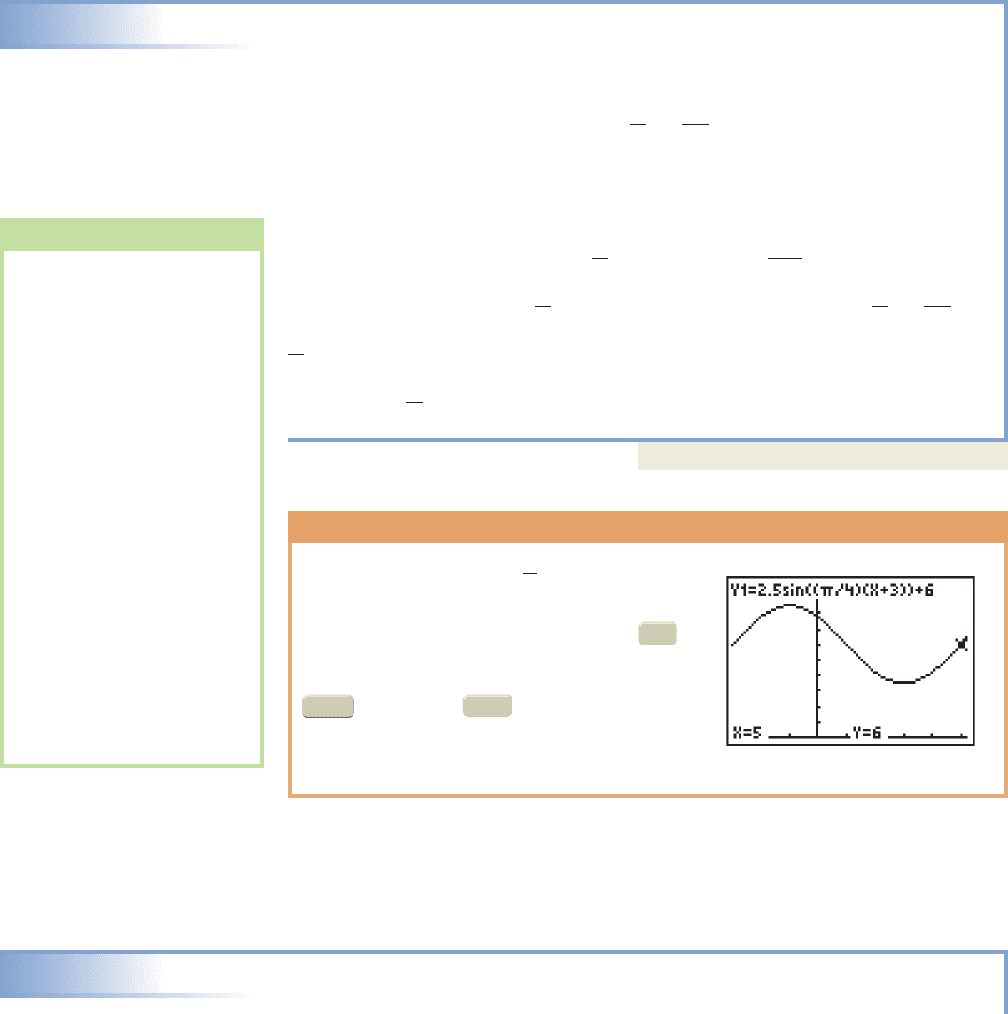
592 CHAPTER 5 An Introduction to Trigonometric Functions 5-90
Knowing where each cycle begins and ends is a helpful part of sketching a graph
of the equation model. The primary interval for a sinusoidal graph can be found by
solving the inequality with the reference rectangle and rule of
fourths giving the zeroes, max/min values, and a sketch of the graph in this interval.
The graph can then be extended in either direction, and shifted vertically as needed.
EXAMPLE 4
Analyzing the Transformation of a Trig Function
Identify the amplitude, period, horizontal shift, vertical shift (average value), and
endpoints of the primary interval.
Solution
The equation gives an amplitude of with an average value of
The maximum value will be with a minimum of
With the period is To find the
horizontal shift, we factor out to write the equation in shifted form:
The horizontal shift is 3 units left. For the endpoints of the primary interval
we solve which gives
Now try Exercises 23 through 34
3 t 6 5.0
4
1t 326 2,
4
1t 32.
a
4
t
3
4
b
4
P
2
/4
8.B
4
,y 2.5112 6 3.5.
y 2.5112 6 8.5,D 6.
A
2.5,
y 2.5 sina
4
t
3
4
b 6
0 Bt C 6 2,
GRAPHICAL SUPPORT
The analysis of from
Example 4 can be verified on a graphing
calculator. Enter the function as Y
1
on the
screen and set an appropriate window size
using the information gathered. Press the
key and and the calculator
gives the average value as output.
Repeating this for shows one complete
cycle has been completed.
x 5
y 6
ENTER
3
TRACE
Y =
y 2.5 sin c
4
1t 32d 6
37
0
10
To help gain a better understanding of sinusoidal functions, their graphs, and the
role the coefficients A, B, C, and D play, it’s often helpful to reconstruct the equation
of a given graph.
EXAMPLE 5
Determining the Equation of a Trig Function from Its Graph
Determine the equation of the given graph using a sine function.
WORTHY OF NOTE
It’s important that you don’t
confuse the standard form
with the shifted form. Each
has a place and purpose, but
the horizontal shift can be
identified only by focusing on
the change in an independent
variable. Even though the
equations and
are equivalent,
only the first explicitly
shows that has been
shifted three units left.
Likewise
and are
equivalent, but only the first
explicitly gives the horizontal
shift (three units left).
Applications involving a
horizontal shift come in an
infinite variety, and the shifts
are generally not uniform or
standard.
y sin12t 62
y sin321t 324
y 4x
2
y 12x 62
2
y 41x 32
2
College Algebra & Trignometry—
cob19529_ch05_503-614.qxd 12/27/08 10:59 Page 592
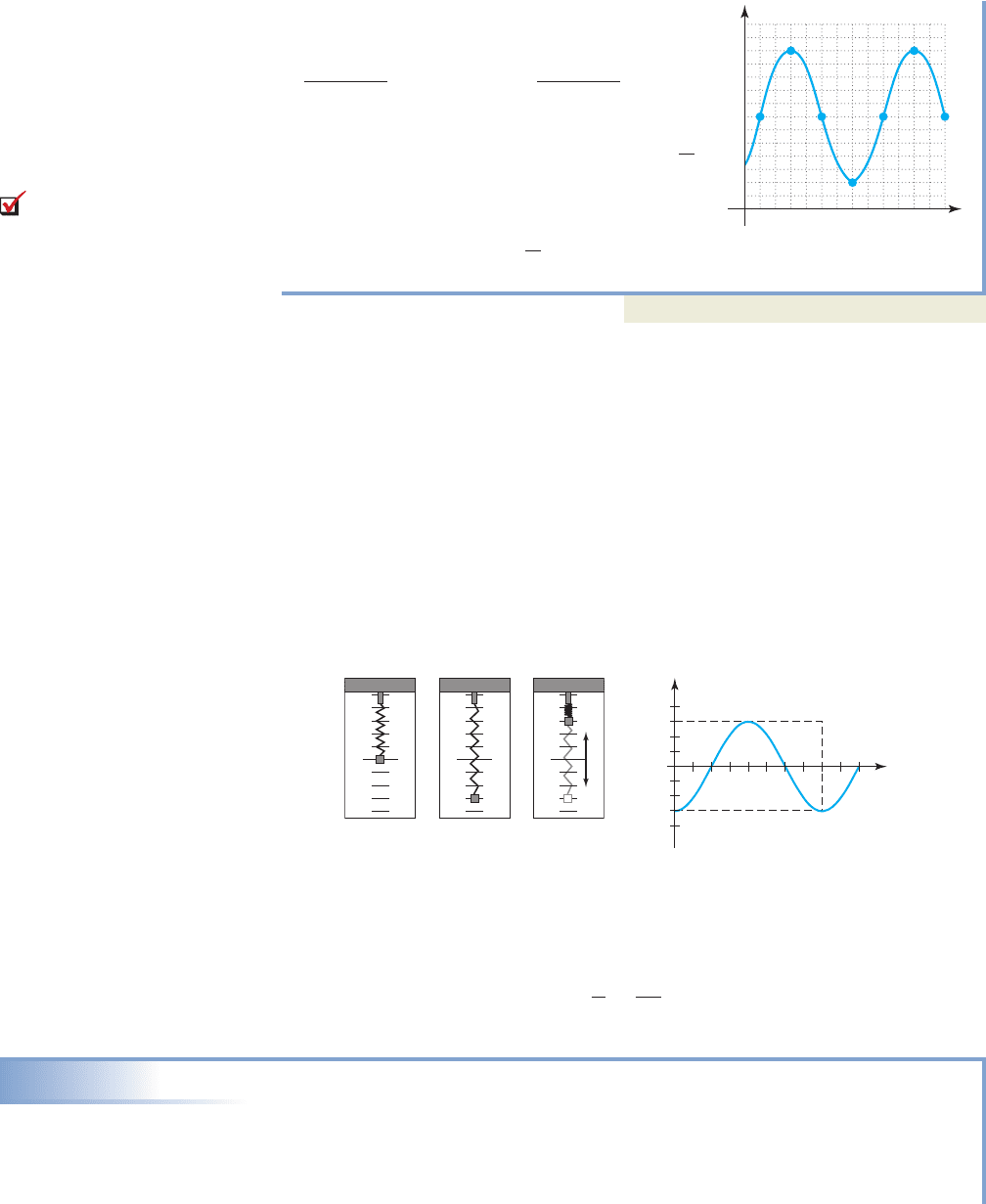
5-91 Section 5.7 Transformations and Applications of Trigonometric Graphs 593
Solution
From the graph it is apparent the maximum value
is 300, with a minimum of 50.This gives a value
of for D and
for A. The graph completes one cycle from
to showing and .
The average value first occurs at so the
basic graph has been shifted to the right 2 units.
The equation is
Now try Exercises 35 through 44
C. Simple Harmonic Motion: or
The periodic motion of springs, tides, sound, and other phenomena all exhibit what is
known as harmonic motion, which can be modeled using sinusoidal functions.
Harmonic Models—Springs
Consider a spring hanging from a beam with a weight attached to one end. When the
weight is at rest, we say it is in equilibrium,or has zero displacement from center. Stretch-
ing the spring and then releasing it causes the weight to “bounce up and down,” with its
displacement from center neatly modeled over time by a sine wave (see Figure 5.87).
For objects in harmonic motion (there are other harmonic models), the input vari-
able t is always a time unit (seconds, minutes, days, etc.), so in addition to the period of
the sinusoid, we are very interested in its frequency—the number of cycles it completes
per unit time (see Figure 5.88). Since the period gives the time required to complete one
cycle, the frequency f is given by
EXAMPLE 6
Applications of Sine and Cosine: Harmonic Motion
For the harmonic motion modeled by the sinusoid in Figure 5.88,
a. Find an equation of the form .
b. Determine the frequency.
c. Use the equation to find the position of the weight at .t 1.8 sec
y A cos1Bt2
f
1
P
B
2
.
0.5 1.0 1.5 2.0 2.5
t (seconds)
Displacement (cm)
Harmonic motion
4
4
0
0
2
2
4
4
At rest
0
2
2
4
4
Stretched
0
2
2
4
4
Released
y A cos1Bt2y A sin1Bt2
y 125 sinc
8
1t 22d 175.
t 2,
B
8
P 18 2 16t 18,
t 2
300 50
2
125
300 50
2
175
B. You’ve just learned
how to apply horizontal
translations in context
24201612840
350
300
250
150
200
100
50
t
y
Figure 5.87 Figure 5.88
College Algebra & Trignometry—
cob19529_ch05_503-614.qxd 11/11/08 1:51 PM Page 593 epg HD 049:Desktop Folder:Coburn_do_t del-ch05:

Solution
a. By inspection the graph has an amplitude and a period After
substitution into we obtain and the equation
b. Frequency is the reciprocal of the period so showing one-half a cycle is
completed each second (as the graph indicates).
c. Evaluating the model at gives meaning
the weight is 2.43 cm below the equilibrium point at this time.
Now try Exercises 47 through 50
Harmonic Models—Sound Waves
A second example of harmonic motion is the production of sound. For the purposes of
this study, we’ll look at musical notes. The vibration of matter produces a pressure
waveor sound energy, which in turn vibrates the eardrum. Through the intricate struc-
ture of the middle ear, this sound energy is converted into mechanical energy and sent
to the inner ear where it is converted to nerve impulses and transmitted to the brain. If
the sound wave has a high frequency, the eardrum vibrates with greater frequency,
which the brain interprets as a “high-pitched” sound. The intensity of the sound wave
can also be transmitted to the brain via these mechanisms, and if the arriving sound
wave has a high amplitude, the eardrum vibrates more forcefully and the sound is inter-
preted as “loud” by the brain. These characteristics are neatly modeled using
. For the moment we will focus on the frequency, keeping the amplitude
constant at .
The musical note known as A
4
or “the A above middle C” is produced with a fre-
quency of 440 vibrations per second, or 440 hertz (Hz) (this is the note most often used
in the tuning of pianos and other musical instruments). For any given note, the same
note one octave higher will have double the frequency, and the same note one octave
lower will have one-half the frequency. In addition, with the value of
can always be expressed as , so A
4
has the equation
(after rearranging the factors). The same note one octave lower is A
3
and has the equation ,
with one-half the frequency. To draw the rep-
resentative graphs, we must scale the t-axis in
very small increments ( )
since for A
4
, and
for A
3
. Both are graphed
in Figure 5.89, where we see that the higher
note completes two cycles in the same inter-
val that the lower note completes one.
EXAMPLE 7
Applications of Sine and Cosine: Sound Frequencies
The table here gives the frequencies for three octaves of the 12 “chromatic” notes
with frequencies between 110 Hz and 840 Hz. Two of the 36 notes are graphed in
the figure. Which two?
P
1
220
0.0045
P
1
440
0.0023
seconds 10
3
y sin322012t24
y sin344012t24
B 2fB 2a
1
P
b
f
1
P
A 1
y A sin1Bt2
y 3 cos311.824 2.43,t 1.8
f
1
2
,
y 3 cos1t2.B P
2
B
,
P 2.
A
3
594 CHAPTER 5 An Introduction to Trigonometric Functions 5-92
12345
t (sec 10
3
)
A
4
y sin[440(2t)]
y
1
1
0
A
3
y sin[220(2t)]
Figure 5.89
College Algebra & Trignometry—
cob19529_ch05_503-614.qxd 11/11/08 1:51 PM Page 594 epg HD 049:Desktop Folder:Coburn_do_t del-ch05:
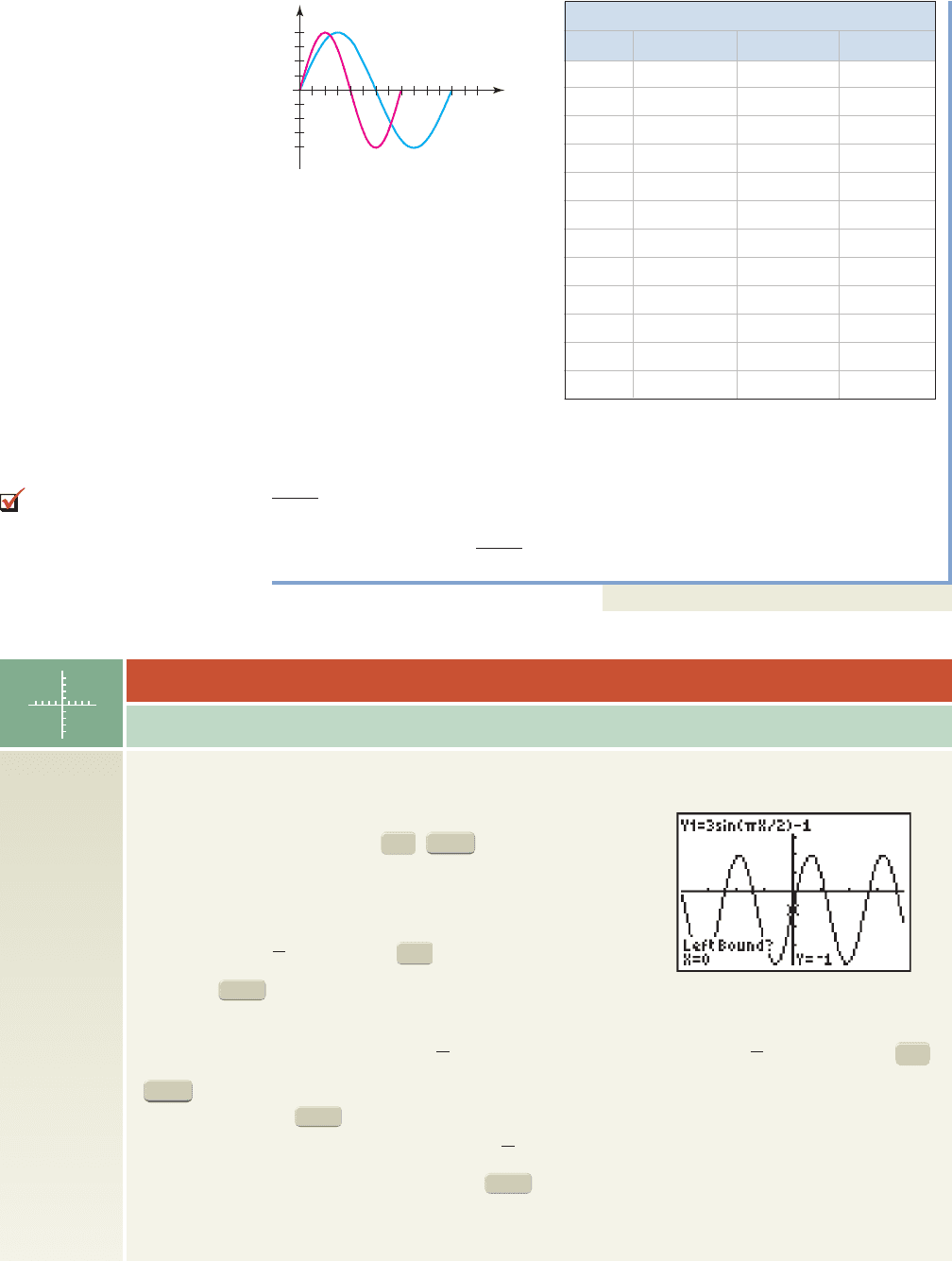
5-93 Section 5.7 Transformations and Applications of Trigonometric Graphs 595
Solution
Since amplitudes are equal, the only difference is the frequency and period of the
notes. It appears that y
1
has a period of about 0.004 sec, giving a frequency of
—very likely a B
4
(in bold). The graph of y
2
has a period of about
0.006, for a frequency of —probably an E
3
(also in bold).
Now try Exercises 51 through 54
1
0.006
167 Hz
1
0.004
250 Hz
5.0 6.0 7.0
t (sec 10
3
)
y
1
sin[ f(2t)]
y
2
sin[ f(2t)]
y
1
1
0
1.0 2.0 3.0 4.0
Frequency by Octave
Note Octave 3 Octave 4 Octave 5
A 110.00 220.00 440.00
A# 116.54 233.08 466.16
B 123.48 246.96 493.92
C 130.82 261.64 523.28
C# 138.60 277.20 554.40
D 146.84 293.68 587.36
D# 155.56 311.12 622.24
E 164.82 329.24 659.28
F 174.62 349.24 698.48
F# 185.00 370.00 740.00
G 196.00 392.00 784.00
G# 207.66 415.32 830.64
C. You’ve just learned how
to solve applications involving
harmonic motion
Locating Zeroes, Roots, and x-Intercepts
TECHNOLOGY HIGHLIGHT
As you know, the zeroes of a function are input values that
cause an output of zero. Graphically, these show up as
x-intercepts and once a function is graphed they can be
located (if they exist) using the 2:zero feature.
This feature is similar to the 3:minimum and 4:maximum
features, in that we have the calculator search a specified
interval by giving a left bound and a right bound. To illustrate,
enter on the screen and graph it
using the 7:ZTrig option. The resulting graph shows
there are six zeroes in this interval and we’ll locate the first negative root. Knowing the 7:Trig option
uses tick marks that are spaced every units, this root is in the interval . After pressing
2:zero the calculator returns you to the graph, and requests a “Left Bound,” (see Figure 5.90).
We enter (press ) and the calculator marks this choice with a “ ” marker (pointing to the right),
then asks for a “Right Bound.” After entering , the calculator marks this with a “ ” marker and asks
for a “Guess.” Bypass this option by pressing once again (see Figure 5.91). The calculator searches
the interval until it locates a zero (Figure 5.92) or displays an error message indicating it was unable to
comply (no zeroes in the interval). Use these ideas to locate the zeroes of the following functions in [ ].
0,
ENTER
>
2
N
ENTER
CALC
2nd
a,
2
b
2
ZOOM
Y =
Y
1
3 sina
2
xb 1
CALC
2nd
6.2
4
4
6.2
Figure 5.90
College Algebra & Trignometry—
cob19529_ch05_503-614.qxd 11/11/08 1:51 PM Page 595 epg HD 049:Desktop Folder:Coburn_do_t del-ch05:

596 CHAPTER 5 An Introduction to Trigonometric Functions 5-94
Exercise 1: Exercise 2:
Exercise 3: Exercise 4: y x
3
cos xy
3
2
tan12x2 1
y 0.5 sin31t 224y 2 cos1t2 1
6.2
4
4
6.2
Figure 5.91
6.2
4
4
6.2
Figure 5.92
5.7 EXERCISES
CONCEPTS AND VOCABULARY
Fill in each blank with the appropriate word or phrase.
Carefully reread the section if needed.
1. A sinusoidal wave is one that can be modeled by
functions of the form ______________ or
_______________.
2. The graph of is the graph of
shifted __________ k units. The graph of
is the graph of shifted
__________ h units.
3. To find the primary interval of a sinusoidal graph,
solve the inequality ____________.
y sin xy sin1x h2
y sin x
y sin x k
4. Given the period P, the frequency is __________,
and given the frequency f, the value of B is
__________.
5. Explain/Discuss the difference between the
standard form of a sinusoidal equation, and the
shifted form. How do you obtain one from the
other? For what benefit?
6. Write out a step-by-step procedure for sketching
the graph of . Include
use of the reference rectangle, primary interval,
zeroes, max/mins, and so on. Be complete and
thorough.
y 30 sina
2
t
1
2
b 10
DEVELOPING YOUR SKILLS
Use the graphs given to (a) state the amplitude A and
period P of the function; (b) estimate the value at ;
and (c) estimate the interval in [0, P] where .f(x)
20
x 14
7. 8.
50
50
30252015105
f (x)
x
50
50
612182430
f (x)
x
College Algebra & Trignometry—
cob19529_ch05_503-614.qxd 11/11/08 1:51 PM Page 596 epg HD 049:Desktop Folder:Coburn_do_t del-ch05:
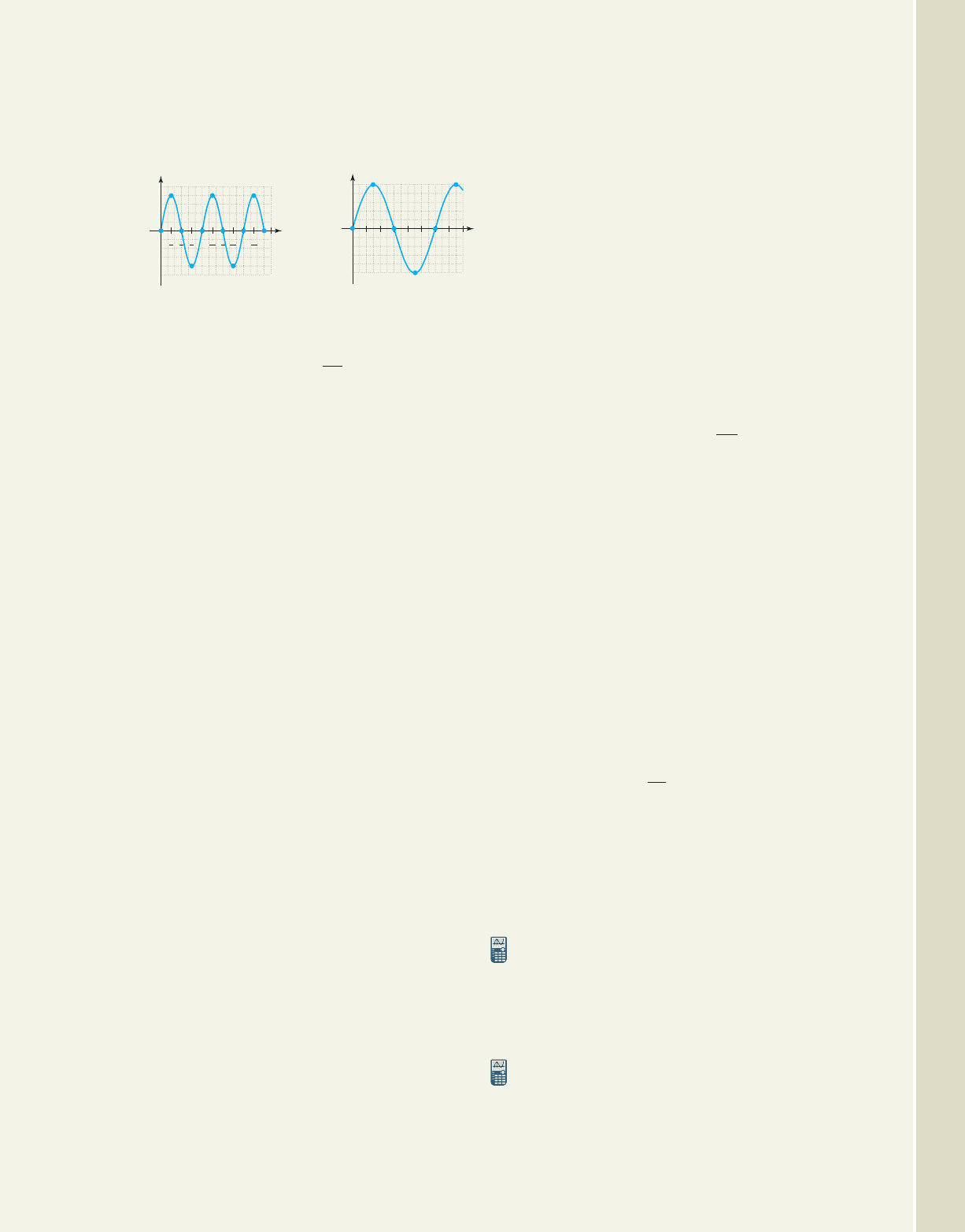
Use the graphs given to (a) state the amplitude A and
period P of the function; (b) estimate the value at ;
and (c) estimate the interval in [0, P], where .
9. 10.
Use the information given to write a sinusoidal equation
and sketch its graph. Recall .
11. Max: 100, min: 20,
12. Max: 95, min: 40,
13. Max: 20, min: 4,
14. Max: 12,000, min: 6500,
Use the information given to write a sinusoidal equation,
sketch its graph, and answer the question posed.
15. In Geneva, Switzerland, the daily temperature in
January ranges from an average high of to an
average low of . (a) Find a sinusoidal equation
model for the daily temperature; (b) sketch the
graph; and (c) approximate the time(s) each
January day the temperature reaches the freezing
point ( ). Assume corresponds to noon.
Source: 2004 Statistical Abstract of the United States,
Table 1331.
16. In Nairobi, Kenya, the daily temperature in January
ranges from an average high of to an average
low of . (a) Find a sinusoidal equation model
for the daily temperature; (b) sketch the graph; and
(c) approximate the time(s) each January day the
temperature reaches a comfortable . Assume
corresponds to noon.
Source: 2004 Statistical Abstract of the United States,
Table 1331.
17. In Oslo, Norway, the number of hours of daylight
reaches a low of 6 hr in January, and a high of
nearly 18.8 hr in July. (a) Find a sinusoidal
equation model for the number of daylight hours
each month; (b) sketch the graph; and
(c) approximate the number of days each year
there are more than 15 hr of daylight. Use
Assume corresponds
to January 1.
Source: www.visitnorway.com/templates.
t 01 month 30.5 days.
t 0
72°F
58°F
77°F
t 032°F
29°F
39°F
P 10
P 360
P 24
P 30
B
2
P
125
125
21357468
f (x)
x
250
250
f (x)
x
3
2
9
2
15
4
21
4
27
4
36
9
4
3
4
f(x) 100
x 2
18. In Vancouver, British Columbia, the number of
hours of daylight reaches a low of 8.3 hr in
January, and a high of nearly 16.2 hr in July.
(a) Find a sinusoidal equation model for the
number of daylight hours each month; (b) sketch
the graph; and (c) approximate the number of days
each year there are more than 15 hr of daylight.
Use . Assume
corresponds to January 1.
Source: www.bcpassport.com/vital/temp.
19. Recent studies seem to indicate the population
of North American porcupine (Erethizon
dorsatum) varies sinusoidally with the solar
(sunspot) cycle due to its effects on Earth’s
ecosystems. Suppose the population of this
species in a certain locality is modeled by the
function , where P(t)
represents the population of porcupines in year t.
Use the model to (a) find the period of the
function; (b) graph the function over one period;
(c) find the maximum and minimum values; and
(d) estimate the number of years the population is
less than 740 animals.
Source: Ilya Klvana, McGill University (Montreal), Master of
Science thesis paper, November 2002.
20. The population of mosquitoes in a given area is
primarily influenced by precipitation, humidity,
and temperature. In tropical regions, these tend to
fluctuate sinusoidally in the course of a year.
Using trap counts and statistical projections,
fairly accurate estimates of a mosquito population
can be obtained. Suppose the population in a
certain region was modeled by the function
, where P(t) was the
mosquito population (in thousands) in week t of
the year. Use the model to (a) find the period of the
function; (b) graph the function over one period;
(c) find the maximum and minimum population
values; and (d) estimate the number of weeks the
population is less than 915,000.
21. Use a horizontal translation to shift the graph from
Exercise 19 so that the average population of the
North American porcupine begins at . Verify
results on a graphing calculator, then find a sine
function that gives the same graph as the shifted
cosine function.
22. Use a horizontal translation to shift the graph from
Exercise 20 so that the average population of
mosquitoes begins at . Verify results on a
graphing calculator, then find a sine function that
gives the same graph as the shifted cosine function.
t 0
t 0
P1t2 50 cosa
26
tb 950
P1t2 250 cosa
2
11
tb 950
t 01 month 30.5 days
5-95 Section 5.7 Transformations and Applications of Trigonometric Graphs 597
College Algebra & Trignometry—
cob19529_ch05_588-600.qxd 01/13/2009 07:40 PM Page 597 ssen 1 HD 049:Desktop Folder:Satya 13/01/09:Used file:MHDQ092-5.7:

Identify the amplitude (A), period (P), horizontal shift
(HS), vertical shift (VS), and endpoints of the primary
interval (PI) for each function given.
23.
24.
25.
26.
27.
28.
29.
30.
31.
32.
33.
34.
y 1450 sina
3
4
t
8
b 2050
y 2500 sina
4
t
12
b 3150
f 1t2 90 sina
10
t
5
b 120
g1t2 28 sina
6
t
5
12
b 92
g1t2 40.6 sinc
6
1t 42d 13.4
f 1t2 24.5 sinc
10
1t 2.52d 15.5
y sina
3
t
5
12
b
y sina
4
t
6
b
r1t2 sina
10
t
2
5
b
h1t2 sina
6
t
3
b
y 560 sinc
4
1t 42d
y 120 sinc
12
1t 62d
Find the equation of the graph given. Write answers in
the form
35. 36.
37. 38.
39. 40.
Sketch one complete period of each function.
41.
42.
43.
44.
p1t22 cosa3t
2
b
h1t2 3 sin14t 2
g1t2 24.5 sinc
10
1t 2.52d 15.5
f 1t2 25 sinc
4
1t 22d 55
24 3630181260
6000
5000
4000
3000
2000
1000
y
t
360270180900
12
10
8
6
4
2
y
t
24 30 36181260
120
140
100
80
60
40
20
t
y
100 1257550250
18
20
16
14
12
10
8
y
t
32241680
120
140
100
80
60
40
20
y
t
24181260
600
700
500
400
300
200
100
t
y
y A sin1Bt C2 D.
598
CHAPTER 5 An Introduction to Trigonometric Functions 5-96
WORKING WITH FORMULAS
45. The relationship between the coefficient B, the
frequency f, and the period P
In many applications of trigonometric functions,
the equation is written as
, where . Justify the new
equation using and . In other words,
explain how A sin(Bt) becomes , as
though you were trying to help another student
with the ideas involved.
A sin312f2t4
P
2
B
f
1
P
B 2fy A sin312f 2t4
y A sin1Bt2
46. Number of daylight hours:
The number of daylight hours for a particular day
of the year is modeled by the formula given, where
D(t) is the number of daylight hours on day t of the
year and K is a constant related to the total
variation of daylight hours, latitude of the location,
and other factors. For the city of Reykjavik,
Iceland, , while for Detroit, Michigan,
. How many hours of daylight will each city
receive on June 30 (the 182nd day of the year)?
K 6
K 17
D1t2
K
2
sinc
2
365
1t 792d 12
College Algebra & Trignometry—
cob19529_ch05_588-600.qxd 01/13/2009 07:40 PM Page 598 ssen 1 HD 049:Desktop Folder:Satya 13/01/09:Used file:MHDQ092-5.7:
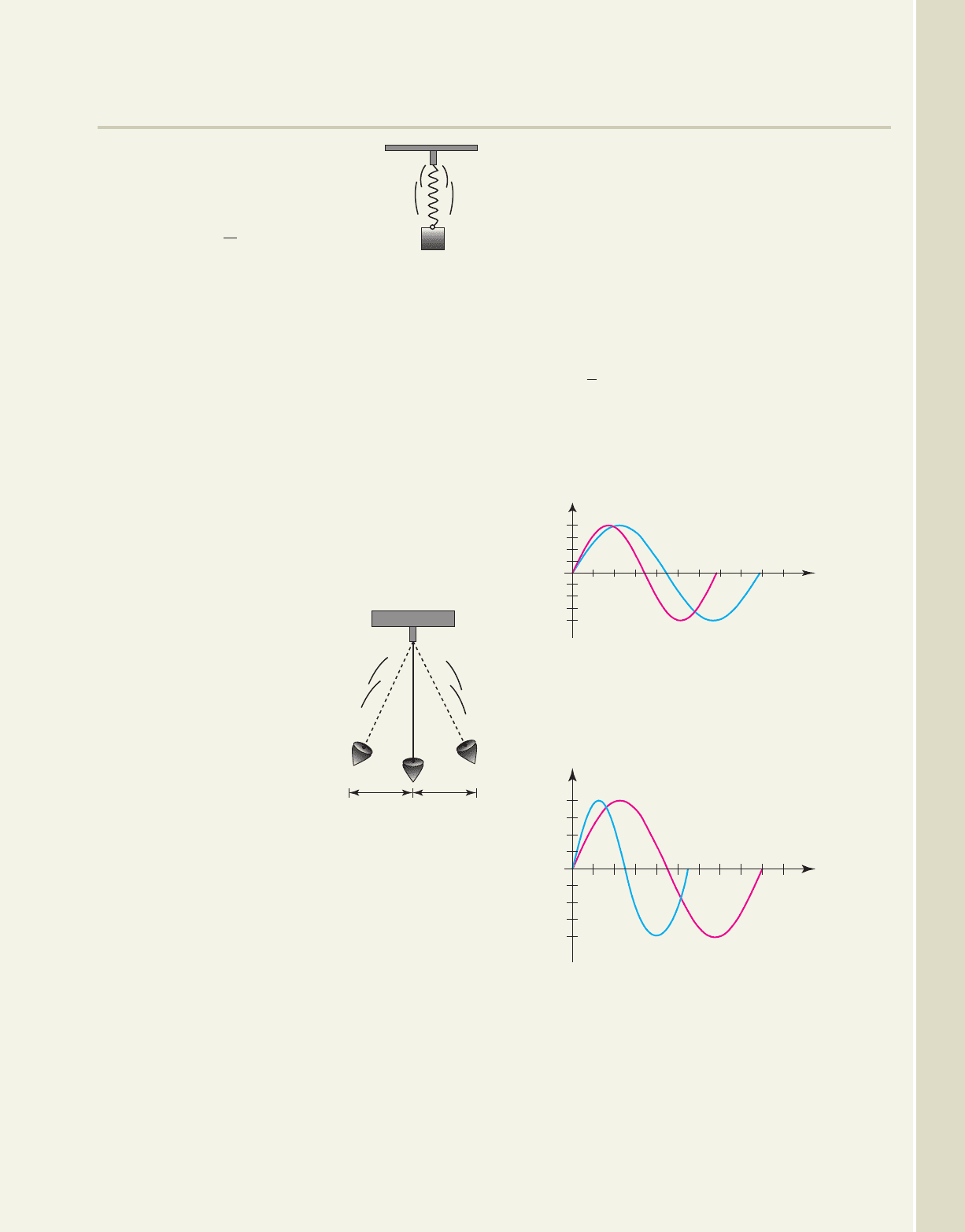
APPLICATIONS
49. Harmonic motion:A simple pendulum 36 in. in
length is oscillating in harmonic motion. The bob at
the end of the pendulum swings through an arc of
30 in. (from the far left to the far right, or one-half
cycle) in about 0.8 sec. What is the equation model
for this harmonic motion?
50. Harmonic motion: As part of a study of wave
motion, the motion of a floater is observed as a
series of uniform ripples of water move beneath it.
By careful observation, it is noted that the floater
bobs up and down through a distance of 2.5 cm
every . What is the equation model for this
harmonic motion?
51. Sound waves: Two of the musical notes from the
chart on page 595 are graphed in the figure. Use
the graphs given to determine which two.
52. Sound waves: Two chromatic notes not on the
chart from page 595 are graphed in the figure. Use
the graphs and the discussion regarding octaves to
determine which two. Note the scale of the t-axis
has been changed to hundredths of a second.
Sound waves: Use the chart on page 595 to write the
equation for each note in the form and
clearly state the period of each note.
53. notes D
3
and G
4
54. the notes A
5
and C#
3
y sin3f(2t)4
0.4 0.8 1.2 1.6 2.0
t (sec 10
2
)
y
1
sin[f (2t)]
y
2
sin[ f (2t)]
y
1
1
0
246810
t (sec 10
3
)
y
1
sin[ f (2t)]
y
2
sin[ f (2t)]
y
1
1
0
1
3
sec
5-97 Section 5.7 Transformations and Applications of Trigonometric Graphs 599
47. Harmonic motion: A weight on
the end of a spring is oscillating in
harmonic motion. The equation
model for the oscillations is
, where d is the
distance (in centimeters) from the equilibrium
point in t sec.
a. What is the period of the motion? What is the
frequency of the motion?
b. What is the displacement from equilibrium at
? Is the weight moving toward the
equilibrium point or away from equilibrium at
this time?
c. What is the displacement from equilibrium at
? Is the weight moving toward the
equilibrium point or away from equilibrium at
this time?
d. How far does the weight move between
and sec? What is the average velocity
for this interval? Do you expect a greater or
lesser velocity for to ? Explain
why.
48. Harmonic motion: The bob
on the end of a 24-in.
pendulum is oscillating in
harmonic motion. The
equation model for the
oscillations is
, where d
is the distance (in inches)
from the equilibrium point,
t sec after being released
from one side.
a. What is the period of the motion? What is the
frequency of the motion?
b. What is the displacement from equilibrium at
? Is the weight moving toward the
equilibrium point or away from equilibrium at
this time?
c. What is the displacement from equilibrium at
? Is the weight moving toward the
equilibrium point or away from equilibrium at
this time?
d. How far does the bob move between
and ? What is its average velocity
for this interval? Do you expect a greater
velocity for the interval to ?
Explain why.
t 0.6t 0.55
t 0.35 sec
t 0.25
t 1.3 sec
t 0.25 sec
d1t2 20 cos14t2
t 2t 1.75
t 1.5
t 1
t 3.5
t 2.5
d1t2 6 sina
2
tb
dd
College Algebra & Trignometry—
cob19529_ch05_503-614.qxd 11/11/08 1:51 PM Page 599 epg HD 049:Desktop Folder:Coburn_do_t del-ch05:
